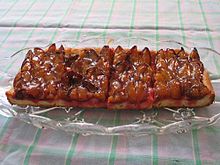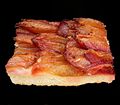Plum cake

Plum cake or plum cake is a sheet cake that is traditionally made from yeast dough . The dough is spread out on a baking sheet and topped with halved or quartered and pitted plums (a subspecies of the plum ). There are also variants made from shortcrust pastry , yeast shortcrust pastry , quark and oil dough or batter . In the Palatinate , Rheinhessen and Lower Franconia , plum cakes are also eaten with potato or vegetable soup as the main course for lunch ("Grumbeersupp mit Quetschekuche"). In the Saarland , on the other hand, bean soup with plum cake is a popular combination ("Bibbelschesbohnesupp un Quetschekuche").
Plum cake can be sprinkled with a little sugar, depending on your taste, to balance the acidity of the plums.
Plum cake is known as summer cake.
Designations
Plum cake and plum cake are sometimes referred to with different proper names in the various regions of Germany, Austria and Switzerland. In their dictionary, the Brothers Grimm were able to identify various old German names for plum biscuits in the literature that are still in use today:
Plum Cake
In dictionaries from the years 1678 and 1712 which is plum cake (Italian torta di prugna, prugnata, or French toured de prunes ) listed.
Plum flatbread
The Brothers Grimm found a mention of a plum cake in a comedy by Joseph von Petrasch from 1765.
Plum cake
The term zwespenkuchen appears in an Austrian idioticon in 1780, quetschenkuchen in the dictionary of Alsatian dialects by Ernst Martin and Hans Lienhart. Pronounced as Quetschekuche in Hesse , Rhineland-Palatinate and Saarland .
Zwetschgendatschi

The Brothers Grimm found plum paws in Swabian and South Moravian writings. In the German provincial dictionary from 1792, Zwetschendatschi is listed as an Augsburg cake. Zwetschgendatschi , often also known as dachi for short , is a culinary specialty of the city of Augsburg . It is also said that the shape of the cut plums on the dachi resembles the Augsburg city arms, the stone pine nut . The word “Datschi” is derived from the Upper and Central German word “detschen” or “datschen”, which can be translated as “press in” (“tatschen”) (the plums are pressed into the dough).
In its more original variant, Augsburg plum dachi is baked with shortcrust pastry and without crumble . Today Datschi can often be found with butter crumbles, which are made from butter, sugar, flour, flaked almonds and a little salt and are sometimes refined with vanilla sugar and cinnamon powder. Early plums give off a lot of juice when baking, which can be bound by a crumble topping, while late prunes, on the other hand, remain relatively firm.
The name Zwetschgendatschi is common in southern Germany and Austria and the short form Datschi is now common throughout Bavaria .
Other names
It is known in the Rhineland and the Eifel under the name Pruumetaat or Prummekooke , in Franconia as Quetschichplôzn ( plum plootz ) , in Silesia as Pflaumakucha ( Schläscher Pflaumakucha) . According to old recipes, Quetschenplatz (around 1780) was also baked from bread dough.
Web links
Individual evidence
- ↑ Apple, streusel or plum cake. Recipe overview from Dr. Oetker , accessed on September 16, 2016.
- ↑ a b Dictionary network - German dictionary by Jacob Grimm and Wilhelm Grimm. Retrieved March 8, 2018 .
- ↑ Matthias Kramer: The new dictionary or word book in (Italian-German and) German-Italian language . Endter, 1678 ( google.de [accessed March 8, 2018]).
- ^ Nouveau Dictionnaire françois-allemand et allemand-françois . Fritsch, 1712 ( google.de [accessed March 8, 2018]).
- ^ Dictionary network - German dictionary by Jacob Grimm and Wilhelm Grimm. Retrieved March 8, 2018 .
- ↑ Joseph von Petrasch: Complete Comedy Plays . Felßecker, 1765 ( google.de [accessed on March 8, 2018]).
- ^ Dictionary network - German dictionary by Jacob Grimm and Wilhelm Grimm. Retrieved March 8, 2018 .
- ↑ Friedrich Nicolai: Description of a journey through Germany and Switzerland . 1785 ( google.de [accessed on March 8, 2018]).
- ↑ Attempt to unite the dialects of Teutschland as an introduction to a complete German dictionary: with definitions of the words and considerable contributions to natural history . bey Joseph Edlen von Kurzböck, 1780 ( google.de [accessed on March 8, 2018]).
- ^ Anton Edler von Klein: German Provincial Dictionary . 1792 ( google.de [accessed on March 8, 2018]).
- ↑ Duden | Dachi | Spelling, meaning, definition, origin. Retrieved March 8, 2018 .
- ^ Alfons Schuhbeck : Zwetschgendatschi with streuseln. In: schuhbeck.de. January 3, 2011, accessed June 14, 2018 .
- ↑ German Encyclopedia or General Real Dictionary of All Arts and Sciences: Blat-Cam. Fourth volume . bey Varrentrapp Sohn and Wenner, 1780 ( google.de [accessed on March 8, 2018]).






